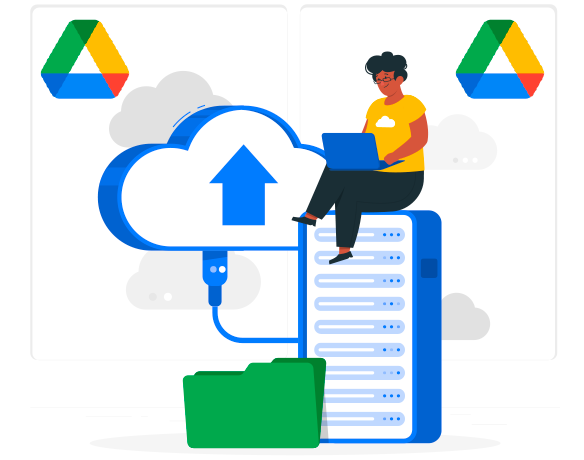
Over the past decade, Gmail, Google Drive, and Google Photos have helped billions of people securely store and manage their emails, documents, photos, videos, and more. Today, people are uploading more content than ever before—in fact, more than 4.3 million GB are added across Gmail, Drive, and Photos every day. With this Google announced in November 2020 that it was updating and changing its storage policy to provide its users with a great experience and to keep pace with the ever-growing demand.
Google has stayed true to this with the rollout of this policy starting with Google Photos on June 1, 2021, and for newly created Google Docs, Sheets, Slides, Drawings, Forms, or Jam Board files under consumer /Free Gmail accounts.
Under Google Photos any new photos or videos uploaded to Google Photos or Google Drive in High-quality count toward the storage limits for users in your domain. Previously, only photos and videos uploaded in Original quality count toward the storage quotas. Please note that any photos or videos uploaded in High quality prior to June 1, 2021, will not be impacted by this change and will not count toward storage limits.
Starting February 1, 2022, ANY newly created Google Docs, Sheets, Slides, Drawings, Forms, and Jam Board files will also count toward the storage limits for users in your domain. Existing files within these products will not count toward storage, unless they’re modified on or after February 1, 2022.

How will this affect my Google Workspace plan?
As of February 1, 2022, any new or edited file within Google Docs, Sheets, Slides, Drawings, Forms, and Jamborad will start to count towards the storage quota. Currently, native Google files don’t count towards storage limits. With this change in the storage policy for Native Google Editors users within our organization will see an increase in storage needs especially for power users within your organization.
What do I need to do?
Storage limits differ across Google Workspace and G Suite editions, but we estimate that the majority of users will not be affected by these changes. Google Workspace and G Suite users can view their current storage allocation by logging into their accounts and accessing Drive storage settings to see how much storage is allocated to the account and what is being consumed.
For Google Workspace administrators you can check your user’s storage usage in the Apps usage user report in the Admin console. For organizations that are currently on Google Workspace Business Starter plan or G Suite Basic that offers each user 30 GB storage allocation, this would be a good time to review your user’s storage needs and requirements and plan accordingly. We would be on hand to help with reviewing this with your team and what would be the best plan for your team moving forward.
What counts towards your storage quota?
- Original quality photos and videos backed up to Google Photos.
- High quality (now named Storage saver) and Express quality photos and videos backed up to Google Photos after June 1, 2021. Any photos or videos you backed up in High quality or Express quality before June 1, 2021, do not count toward your Google Account storage. Learn more about this change.
- Gmail messages and attachments, which include your Spam and Trash folders.
- Files in Google Drive, which includes PDFs native Microsoft files(Word, Excel, and Powerpoint), images, and videos.
What are the available options as a Google Workspace customer?
- Purchase of Additional Storage Plan on Google Workspace:
Google offers additional storage plans that can be assigned to individual user accounts with high storage needs, these plans range from 20GB to 16TB and can be purchased once a user has exceeded the current storage allocation. - A Full domain upgrade to a higher Google Workspace plan:
As an organization instead of purchasing additional storage licenses for your power users, you can switch to a Google Workspace edition that gives you more storage per user and pooled storage for the organization. This can be a way to cut down on costs while also availing additional features such as Shared Drives, Recording within Google Meet, and Google Vault to your organization that will help you enforce more control over your data while boosting collaboration. - Partial domain licenses with a Mix of different Google Workspace plans
Partial Domain Licensing (PDL) refers to special plans that allow organizations to mix different Google Workspace Plans under a single domain/tenancy. Customers can have a subset of users on the Business Starter Plan; while others on a mix of either or all of Business Standard, Plus, and even Enterprise plans! The mixing ratios for the plans depend on other factors and approval from the Google Sales team.
This can be a great way to meet the specific needs of an organization’s requirements and budget. For instance, if you are an organization that is on Business Starter, perhaps you will notice some critical and power users can run out of storage capacity so you have to buy additional storage plans. For a start, PDL would allow you to grant them higher storage access through the higher plans such as 2TB or 5TB for Business standard or plus plans.
You may also do a PDL to meet some requirements for regulatory or internal requirements for data loss protection (DLP), data retention (Vault/eDiscovery) for some subset of users inbox but without breaking the bank to upgrade all users! This is where we can be of help. Other Applications and benefits would be granted to the organization and users who are on the higher plans. Talk to us to understand how we can help you with your choice of plan and SKU today:
Pawa IT Solutions Limited,
1st Floor, George Padmore Ridge,
George Padmore Road,
Nairobi, Kenya
Tel : +254 778 072 282,
Mobile:+254 717 845 316
[email protected] || [email protected]
www.pawait.co.ke || www.pawait.africa.








